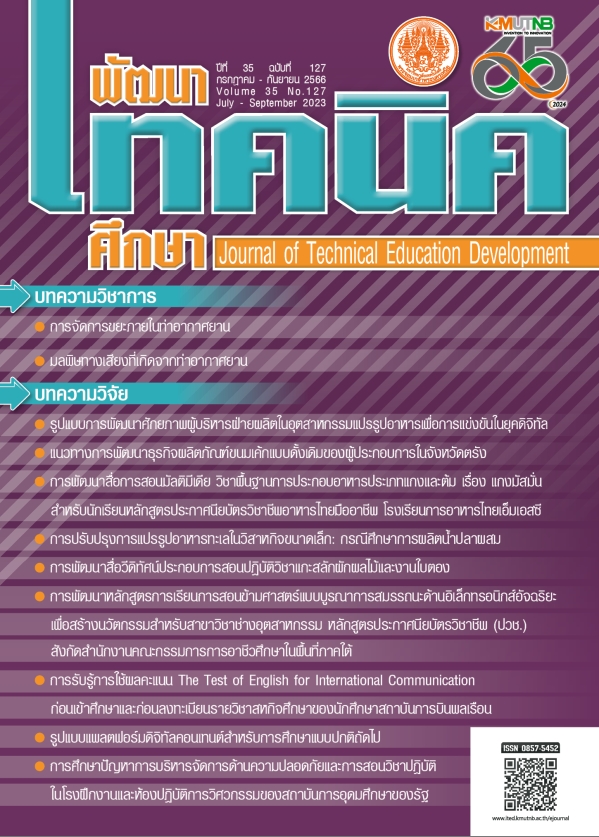การจัดการขยะภายในท่าอากาศยาน
Main Article Content
บทคัดย่อ
บทความวิชาการฉบับนี้ มุ่งศึกษาเรื่องของการจัดการขยะภายในท่าอากาศยาน เนื่องจากการเติบโตของอุตสาหกรรมการขนส่งทางอากาศที่คาดว่าจะยังคงเติบโตอย่างรวดเร็ว หนึ่งในผลกระทบที่ได้จากธุรกิจขนส่งทางอากาศคือขยะที่มาจากภายในอาคารท่าอากาศยานและขยะจากกิจกรรมทางการบิน ที่ทำให้เกิดปัญหามลพิษและสิ่งแวดล้อม ซึ่งส่งผลกระทบต่อพื้นที่ชุมชนโดยรอบท่าอากาศยาน ทั้งนี้เพื่อลดผลกระทบจากปัญหาขยะ ท่าอากาศยานทุกแห่งต้องมีกระบวนการจัดการและการดำเนินการในส่วนของขยะอย่าง ถูกหลัก มีประสิทธิภาพและคุ้มค่า บทความนี้ผู้เขียนนำเสนอกรณีศึกษาแนวคิดการลดขยะให้เป็นศูนย์ (Zero Waste) โดยใช้หลักการ 3Rs (Reduce, Reuse and Recycle) ร่วมกับลำดับขั้นในการจัดการขยะ เพื่อลดการเกิดขยะใหม่ใน
ท่าอากาศยานให้มากที่สุด โดยมีท่าอากาศยานนานาชาติคันไซ ที่มีการดำเนินการจัดการขยะที่ดีที่สุดของโลก อีกทั้งยังมีท่าอากาศยานแซนดีเอโกและท่าอากาศยานลอนดอนแกตวิค ที่มุ่งเน้นการลดปริมาณขยะต่อจำนวนผู้โดยสารและเครื่องบิน โดยการวิเคราะห์ข้อมูลเชิงคุณภาพ และศึกษาวิธีการเพิ่มอัตราการรีไซเคิลและลดอัตราการฝังกลบ เพื่อให้บรรลุเป้าหมายของท่าอากาศยานที่เป็นมิตรกับสิ่งแวดล้อม และการจัดการขยะที่ยั่งยืนของท่าอากาศยาน
Article Details

อนุญาตภายใต้เงื่อนไข Creative Commons Attribution-NonCommercial-NoDerivatives 4.0 International License.
เอกสารอ้างอิง
Baxter, G., Srisaeng, P., & Wild, G. (2018). An assessment of airport sustainability, part 1—waste management at Copenhagen Airport. Resources, 7(1), 21.
Pitt, M., & Smith, A. (2003). Waste management efficiency at UK airports. Journal of Air Transport Management, 9(2), 103-111.
Pitt, M., Brown, A., & Smith, A. (2002). Waste management at airports. Facilities.
Baxter, G., Srisaeng, P., & Wild, G. (2018). Sustainable airport waste management: The case of Kansai international airport. Recycling, 3(1), 6.
Lam, C. M., Iris, K. M., Medel, F., Tsang, D. C., Hsu, S. C., & Poon, C. S. (2018). Life-cycle cost-benefit analysis on sustainable food waste management: The case of Hong Kong International Airport. Journal of Cleaner Production, 187, 751-762.
Sarbassov, Y., and others. (2020). Municipal solid waste management and greenhouse gas emissions at international airports: a case study of Astana International Airport. Journal of Air Transport Management, 85, 101789.
Santos, A. J., Mancini, S. D., Roveda, J. A. F., Ewbank, H., & Roveda, S. R. M. M. (2020). A fuzzy assessment method to airport waste management: A case study of Congonhas Airport, Brazil. Journal of Air Transport Management, 87, 101838.
Chandrappa, R., & Das, D. B. (2012). Solid waste management: Principles and practice. Springer Science & Business Media.
Baxter, G., Wild, G., & Sabatini, R. (2014, November). A sustainable approach to airport design and operations: Case study of Munich airport. In PRCC 2014 Engineers Australia Convention (pp. 227-237).
Turner, M. E. (2018). Airport Waste Management and Recycling Practices (No. Project 11-03, Topic S02-18).
Switzenbaum, M. S., & others (2001). Best management practices for airport deicing stormwater. Chemosphere, 43(8), 1051-1062.
Yuan, H. (2013). A SWOT analysis of successful construction waste management. Journal of cleaner production, 39, 1-8.
Rhyner, C. R., Schwartz, L. J., Wenger, R. B., & Kohrell, M. G. (2017). Waste management and resource recovery. CRC Press.
Pichtel, J. (2014). Waste management practices. CRC press.
Zhu, D., Asnani, P. U., Zurbrugg, C., Anapolsky, S., & Mani, S. K. (2007). Improving municipal solid waste management in India: A sourcebook for policymakers and practitioners. The World Bank.
บริษัท ท่าอากาศยานไทย จำกัด (มหาชน). (2561). [ออนไลน์]. รายงานประจำปี 2563 – การจัดการของเสีย [สืบค้นเมื่อวันที่ 30 มีนาคม 2564]. จาก https://corporate.airportthai.co.th/ storage/ 2021/01/AnnualReport2020th.pdf


